Channel Prediction Technology Based on Adaptive Reinforced Reservoir Learning Network for Orthogonal Frequency Division Multiplexing Wireless Communication Systems
Abstract
1. Introduction
- (1)
- Based on the ESN model and the NGRCN model, the channel prediction model based on the adaptive RRLN is proposed for OFDM wireless communication systems in detail, including the output weight matrix estimation method, i.e., the adaptive EN and the local predictability enhancement method for CSI, i.e., the adaptive SSA.
- (2)
- Extensive evaluations (i.e., computational complexity analysis, one-step prediction, multi-step prediction, and the robust prediction test) are presented and discussed in this paper.
2. Related Theory
2.1. Channel-Estimation Technique for OFDM Wireless Communication Systems
2.2. Next-Generation Reservoir Calculation Network
3. Channel Prediction Method Based on the Adaptive RRLN
3.1. Overall Calculation Methodology
| Algorithm 1: The training process of the adaptive RRLN. |
| Input: Neuron number in the input layer , neuron number in reservoir , spectral radius , balance coefficient , scaling factor and sparse degree SD, input matrix , output matrix , the total prediction step h, and regularization coefficients and . Output: Well-trained adaptive RRLN. |
| Step 1: Optimize using an adaptive SSA; Step 2: Generate in a certain range; Step 3: Calculate using Equation (7); Step 4: Calculate using Equation (8); Step 5: Obtain using Equation (6); Step 6: Estimate the output weight matrix using adaptive EN; Step 7: Output the well-trained adaptive RRLN model. |
3.2. Estimation of Output Weight Matrix Using Adaptive EN
| Algorithm 2: Output weight matrix process using adaptive EN. |
| Input: The output matrix of the hidden layer , the output matrix of the output layer , the total prediction step h, and the regularization coefficients and . Output: Output weight matrix . |
| For : Step 1: Calculate using Equation (14); Step 2: Calculate using Equation (15); Step 3: Calculate using Equation (16); Step 4: Solve Equation (13) using LARS to obtain ; End Step 5: Output the weight matrix using Equation (18). |
3.3. Local Predictability Enhancement Method Using Adaptive SSA
| Algorithm 3: The calculation process of the adaptive RRLN. |
| Input: The channel state information ; ; the window length ; the SNR . Output: . |
| Step 1: Randomly generate the mapping matrix ; Step 2: Obtain using Equation (20); Step 3: Obtain using Equation (22); Step 4: Calculate , , and using Equation (21); Step 5: Calculate using Equation (23); Step 6: Determine using Equation (25); Step 7: Calculate using Equation (24). |
3.4. Calculation Complexity Analysis
4. Simulation and Discussion
4.1. Parameter Settings
4.2. One-Step Prediction Analysis
4.3. Multi-Step Prediction
4.4. Robust Prediction Test
5. Conclusions
Author Contributions
Funding
Data Availability Statement
Conflicts of Interest
References
- Li, S.; Yuan, J.; Fitzpatrick, P.; Sakurai, T.; Caire, G. Delay-Doppler Domain Tomlinson-Harashima Precoding for OTFS-Based Downlink MU-MIMO Transmissions: Linear Complexity Implementation and Scaling Law Analysis. IEEE Trans. Commun. 2023, 71, 2153–2169. [Google Scholar] [CrossRef]
- Dong, G.; Guo, J.; Xun, Q.; Wang, F.; Peng, P. Engineering Implementation Methods of Anti-interference Performance Improvement for Data Link System. Guid. Fuze 2024, 45, 34–39. [Google Scholar]
- Lu, W.; Zhu, B. Automatic modulation recognition of communication signals based on feature fusion. Sci. Technol. Eng. 2024, 24, 9914–9920. [Google Scholar]
- Gonzalez-Atienza, M.; Vanoost, D.; Verbeke, M.; Pissoort, D. An Optimized Adaptive Bayesian Algorithm for Mitigating EMI-Induced Errors in Dynamic Electromagnetic Environments. IEEE Trans. Electromagn. Compat. 2024, 66, 2085–2094. [Google Scholar] [CrossRef]
- Ye, A.; Chen, H.; Natsuaki, R.; Hirose, A. Polarization-Aware Channel State Prediction Using Phasor Quaternion Neural Networks. IEEE Trans. Mach. Learn. Commun. Netw. 2024, 2, 1628–1641. [Google Scholar] [CrossRef]
- Sun, Y. Research on Environmental Information Representation and Channel Prediction for 6G Wireless Communication; Beijing University of Posts and Telecommunications: Beijing, China, 2024. [Google Scholar]
- Fan, B.; Zhou, J. A Simple Exponential Smoothing Channel Prediction Algorithm in Massive MIMO System. Commun. Technol. 2024, 57, 354–358. [Google Scholar]
- Gao, C.; Zhu, Z.; Li, H.; Wang, G.; Zhou, T.; Li, X.; Meng, Q.; Zhou, Y.; Zhao, S. A Fiber-Transmission-Assisted Fast Digital Self-Interference Cancellation for Overcoming Multipath Effect and Nonlinear Distortion. J. Light. Technol. 2023, 41, 6898–6907. [Google Scholar] [CrossRef]
- Huang, C.T.; Huang, Y.C.; Shieh, S.L.; Chen, P.N. Novel Prony-Based Channel Prediction Methods for Time-Varying Massive MIMO Channels. In Proceedings of the IEEE Conference on Vehicular Technology (VTC2024-Spring), Singapore, 24–27 June 2024; pp. 1–6. [Google Scholar]
- Liu, Z.; Zhang, D.; Guo, J.; Tsiftsis, T.A.; Su, Y.; Davaasambuu, B.; Garg, S.; Sato, T. A Spatial Delay Domain-Based Prony Channel Prediction Method for Massive MIMO LEO Communications. IEEE Syst. J. 2023, 17, 4137–4148. [Google Scholar] [CrossRef]
- Chen, Y. Research on Wireless Channel Prediction and Localization Based on Deep Learning; Beijing University of Posts and Telecommunications: Beijing, China, 2024. [Google Scholar]
- Ji, S.; Sun, Y.; Peng, M. Research on satellite-ground adaptive modulation and coding techniques based on intelligent prediction of channel state. Telecommun. Sci. 2024, 40, 1–13. [Google Scholar]
- Gonzalez, J.; Dipu, S.; Sourdeval, O.; Siméon, A.; Camps-Valls, G.; Quaas, J. Emulation of Forward Modeled Top-of-Atmosphere MODIS-Based Spectral Channels Using Machine Learning. IEEE J. Sel. Top. Appl. Earth Obs. Remote Sens. 2025, 18, 1896–1911. [Google Scholar] [CrossRef]
- Fan, D.; Zhan, H.; Xu, F.; Zou, Y.; Zhang, Y. Research on Multi-Channel Spectral Prediction Model for Printed Matter Based on HMSSA-BP Neural Network. IEEE Access 2025, 13, 2340–2359. [Google Scholar] [CrossRef]
- Lv, C.W.; Lin, J.C.; Yang, Z.C. CSI Calibration for Precoding in Mmwave Massive MIMO Downlink Transmission Using Sparse Channel Prediction. IEEE Access 2020, 8, 154382–154389. [Google Scholar] [CrossRef]
- Xiao, Y.; Liu, J.; Long, Z.; Qiu, C. A data-driven approach to wireless channel available throughput estimation and prediction. Chin. J. Internet Things 2023, 7, 32–41. [Google Scholar]
- Wang, Z. Research on Intelligent Channel Prediction for Underwater Acoustic OFDM Communication; Huazhong University of Science and Technology: Wuhan, China, 2021. [Google Scholar]
- Wu, L. Research on Low Processing Delay Receiver Technology in Burst Communication System; University of Electronic Science and Technology of China: Chengdu, China, 2022. [Google Scholar]
- Chen, Z. Massive MIMO Channel Prediction Based on Autoregressive Model; University of Electronic Science and Technology of China: Chengdu, China, 2022. [Google Scholar]
- Li, Y. Research on 3D MIMO Channel Prediction Technology; Xidian University: Xi’an, China, 2020. [Google Scholar]
- Zheng, Y.; Tan, Y. An OFDM channel prediction method based on adaptive jump learning network. J. Nanjing Univ. Posts Telecommun. (Nat. Sci. Ed.) 2023, 43, 51–63. [Google Scholar]
- Luo, Y.; Tian, Q.; Wang, C.; Zhang, J. Biomarkers for Prediction of Schizophrenia: Insights from Resting-State EEG Microstates. IEEE Access 2020, 8, 213078–213093. [Google Scholar] [CrossRef]
- Jiang, W.; Schotten, H.D. Deep Learning for Fading Channel Prediction. IEEE Open J. Commun. Soc. 2020, 1, 320–332. [Google Scholar] [CrossRef]
- Pereira, P.E.; Moualeu, J.M.; Nardelli, P.H.; Li, Y.; de Souza, R.A. An Efficient Machine Learning-Based Channel Prediction Technique for OFDM Sub-Bands. In Proceedings of the 2024 IEEE 99th Vehicular Technology Conference (VTC2024-Spring), Singapore, 24–27 June 2024; pp. 1–5. [Google Scholar]
- Jaeger, H.; Haas, H. Harnessing nonlinearity: Predicting chaotic systems and saving energy in wireless communication. Science 2004, 304, 78–80. [Google Scholar] [CrossRef]
- Xu, M.; Yang, Y.; Han, M.; Qiu, T.; Lin, H. Spatial-temporal interpolated echo state network for meteorological series prediction. IEEE Trans. Neural Netw. Learn. Syst. 2019, 30, 1621–1634. [Google Scholar] [CrossRef]
- Shi, P.; Guo, X.; Du, Q.; Xu., X.; He., C.; Li, R. Photovoltaic power prediction based on Tcn-BILSTM-attention-ESN. Acta Energiae Solaris Sin. 2024, 45, 304–316. [Google Scholar]
- Bai, Y.; Lun, S. Optimization of time series prediction of Echo state network based on war strategy algorithm. J. Bohai Univ. (Nat. Sci. Ed.) 2024, 45, 154–160. [Google Scholar]
- Zhao, Y.; Gao, H.; Beaulieu, N.C.; Chen, Z.; Ji, H. Echo state network for fast channel prediction in Ricean fading scenarios. IEEE Commun. Lett. 2017, 21, 672–675. [Google Scholar] [CrossRef]
- He, Y.; Sui, Y.; Farhan, A. Research of the time-domain channel prediction for adaptive OFDM systems. J. Electron. Meas. Instrum. 2021, 35, 100–110. [Google Scholar]
- Zhang, J.; Guo, Y.; Zhang, L.; Zong, Q. Adaptive communication networking method of charging pile based on channel prediction. Guangdong Electr. Power 2023, 36, 1–8. [Google Scholar]
- Gauthier, D.J.; Bollt, E.; Griffith, A.; Barbosa, W.A. Next generation reservoir computing. Nat. Commun. 2021, 12, 55–64. [Google Scholar] [CrossRef] [PubMed]
- An, H.; Al-Mamun, M.S.; Orlowski, M.K.; Liu, L.; Yi, Y. Robust Deep Reservoir Computing Through Reliable Memristor With Improved Heat Dissipation Capability. IEEE Trans. Comput.-Aided Des. Integr. Circuits Syst. 2021, 40, 574–583. [Google Scholar] [CrossRef]
- Slonopas, A.; Cooper, H.; Lynn, E. Next-Generation Reservoir Computing (NG-RC) Machine Learning Model for Advanced Cybersecurity. In Proceedings of the IEEE Annual Computing and Communication Workshop and Conference (CCWC), Las Vegas, NV, USA, 8–10 January 2024; pp. 0014–0021. [Google Scholar]
- Haluszczynski, A.; Köglmayr, D.; Räth, C. Controlling dynamical systems to complex target states using machine learning: Next-generation vs. In classical reservoir computing. In Proceedings of the International Joint Conference on Neural Networks (IJCNN), Gold Coast, Australia, 18–23 June 2023; pp. 1–7. [Google Scholar]
- Liu, Y.; Chen, M.; Pan, C.; Gong, T.; Yuan, J.; Wang, J. OTFS Versus OFDM: Which is Superior in Multiuser LEO Satellite Communications. IEEE J. Sel. Areas Commun. 2025, 43, 139–155. [Google Scholar] [CrossRef]
- Gao, H.; Zang, B.B. New power system operational state estimation with cluster of electric vehicles. J. Frankl. Inst. 2023, 360, 8918–8935. [Google Scholar] [CrossRef]
- Sui, Y.; Gao, H. Adaptive echo state network based-channel prediction algorithm for the internet of things based on the IEEE 802.11ah standard. Telecommun. Syst. 2022, 81, 503–526. [Google Scholar] [CrossRef]
- Zhu, P.; Wang, H.; Ji, Y.; Gao, G. A Novel Performance Enhancement Optical Reservoir Computing System Based on Three-Loop Mutual Coupling Structure. J. Lightwave Tech. 2024, 42, 3151–3162. [Google Scholar] [CrossRef]
- Kent, R.; Barbosa, W.S.; Gauthier, D.J. Controlling chaotic maps using next-generation reservoir computing. Chaos Interdiscip. J. Nonlinear Sci. 2024, 34, 1–11. [Google Scholar]
- Hailin, L. A modified newton method for unconstrained convex optimization. In Proceedings of the 2008 International Symposium on Information Science and Engineering, Shanghai, China, 20–22 December 2008; pp. 754–757. [Google Scholar]
- Hui, Y.; Zhibin, H.; Feng, Z. Application of BP neural network based on quasi-newton method in aerodynamic modeling. In Proceedings of the 2017 16th International Symposium on Distributed Computing and Applications to Business, Engineering and Science (DCABES), Anyang, China, 13–16 October 2017; pp. 93–96. [Google Scholar]
- Efron, B.; Hastie, T.; Johnstone, I.; Tibshirani, R. Least angle regression. Ann. Stat. 2004, 32, 407–451. [Google Scholar] [CrossRef]
- Ma, Y.; Su, J.; Fan, X.; Yang, Q.; Gao, Y.; Huang, Z.; Jiang, R. A Computational Model of MI-EEG Association Prediction Based on SMR-DCT and LS-SVM. In Proceedings of the International Conference on Intelligent Autonomous Systems, Dalian, China, 23–25 September 2022; pp. 351–357. [Google Scholar]
- Chang, C.C.; Lin, C.J. LIBSVM: A library for support vector machines. ACM Trans. Intell. Syst. Technol. 2011, 2, 1–27. [Google Scholar] [CrossRef]
- Sui, Y. Research on Nonlinear Channel Prediction Method for Adaptive OFDM Systems Based on Echo State Network; Hefei University of Technology: Hefei, China, 2021. [Google Scholar]

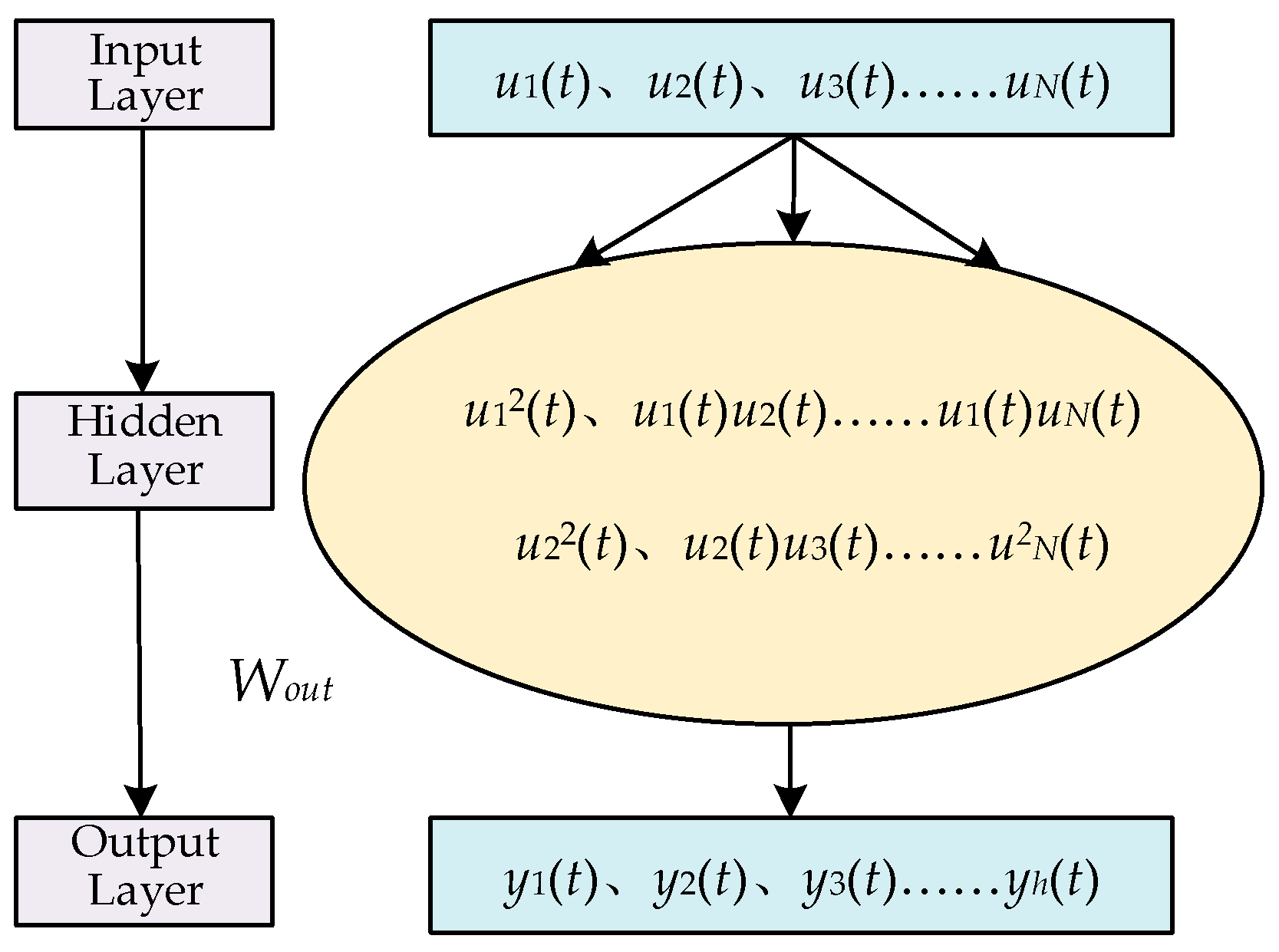
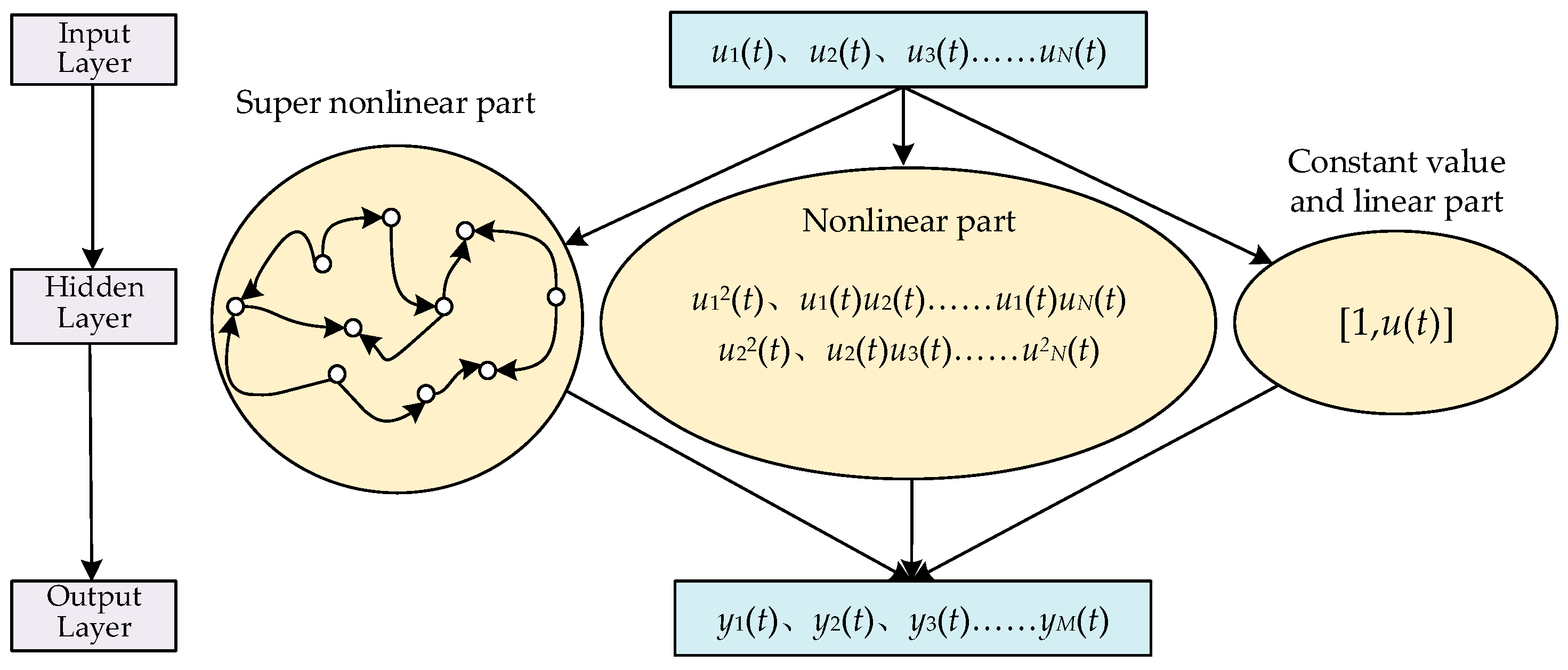
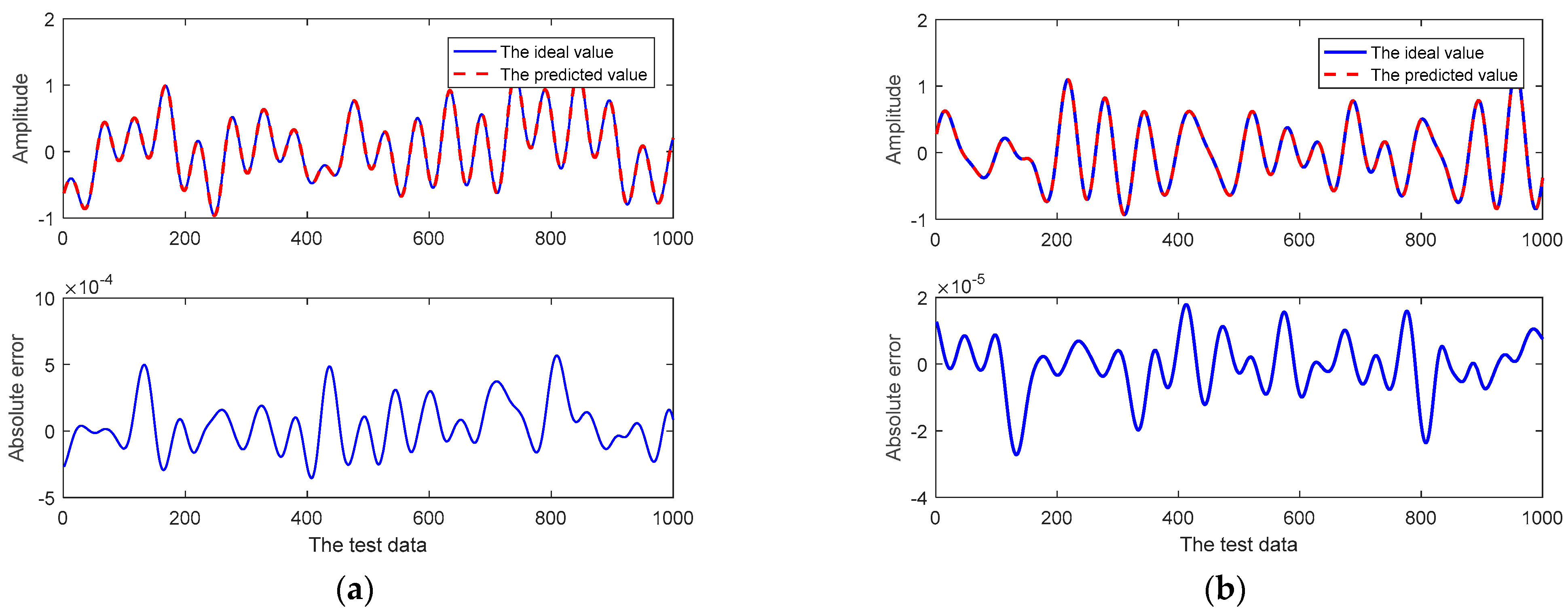
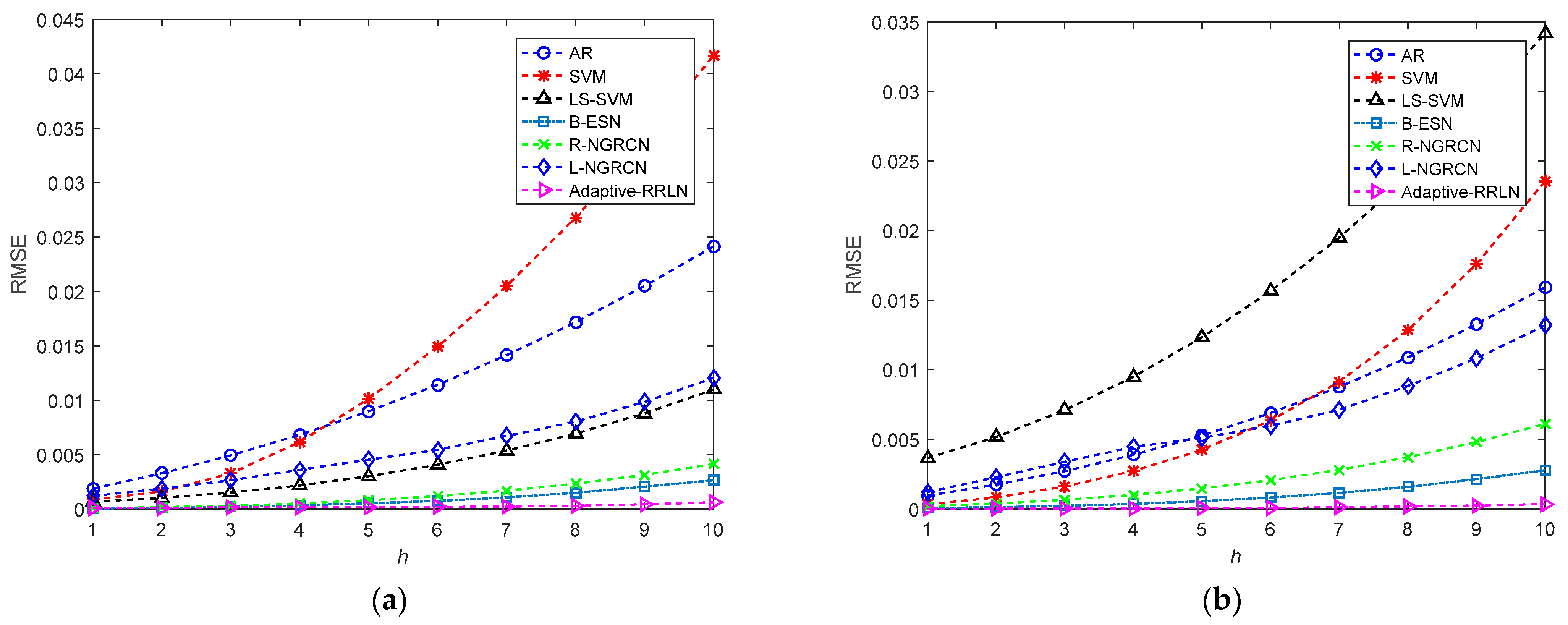


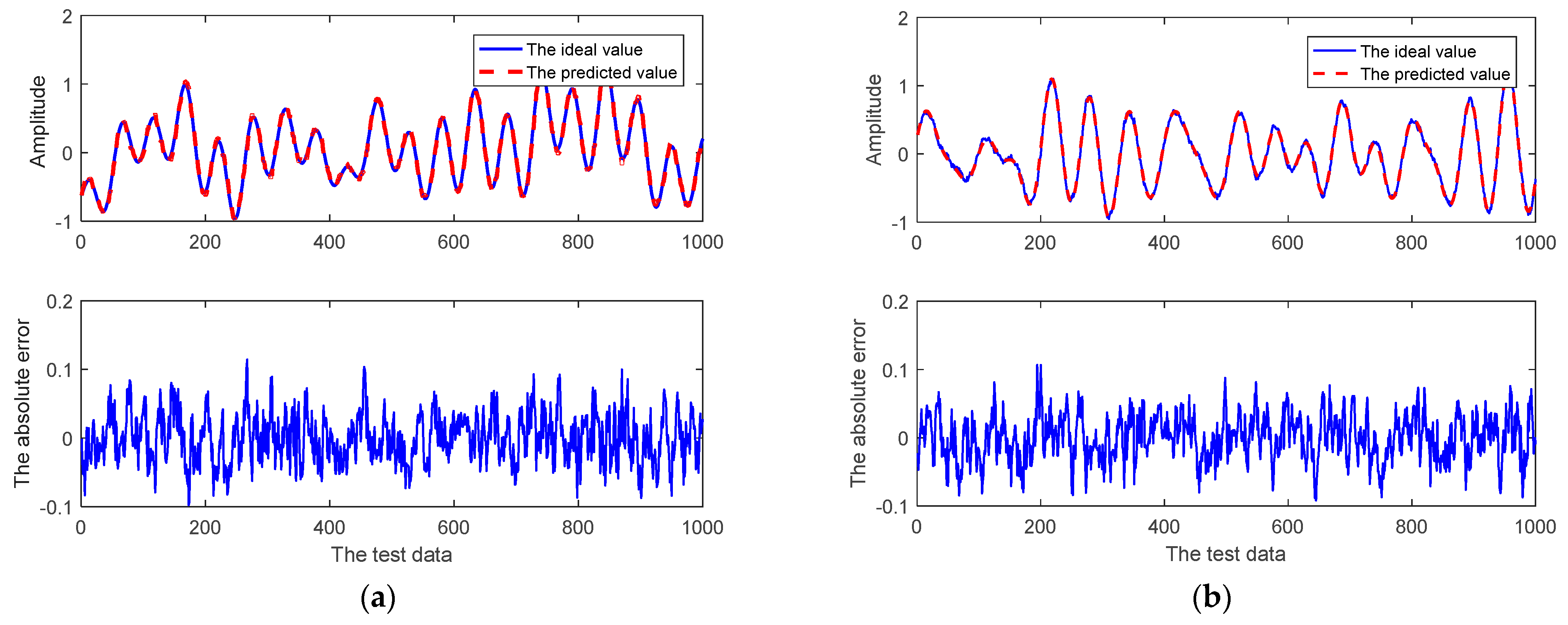
| Model | CC-TrPr | CC-PePr |
|---|---|---|
| AR [15] | ||
| SVM [22] | ||
| LS-SVM [44] | ||
| B-ESN [25] | ||
| R-NGRCN [39] | ||
| L-NGRCN [40] | ||
| Adaptive RRLN |
| Symbol | Meaning | Value |
|---|---|---|
| The carrier frequency | 780 MHz | |
| The bandwidth | 2 MHz | |
| The OFDM symbol rate | 25 kHz | |
| MD | The modulation method | QPSK |
| K | The subcarrier number per OFDM symbol | 52 |
| The pilot subcarrier number per OFDM symbol | 4 | |
| The maximum Doppler shift | 70 Hz | |
| The sampling rate | 2 MHz |
| Data Set | Parameter | Value |
|---|---|---|
| Real component | Input neuron number | 30 |
| SP neuron number | 200 | |
| Sparsity of SP | 0.05 | |
| Spectral radius | 0.09 | |
| Balance factor | 1 | |
| Scaling factor | 0.01 | |
| Regularization factors | 1 × 10−6, 1 × 10−7 | |
| Convergence accuracy | 1 × 10−8 | |
| Window length | 10 | |
| Imaginary component | Input neuron number | 30 |
| SP neuron number | 200 | |
| Sparsity of SP | 0.05 | |
| Spectral radius | 0.09 | |
| Balance factor | 1 | |
| Scaling factor | 0.01 | |
| Regularization factors | 4 × 10−5, 1 × 10−8 | |
| Convergence accuracy | 1 × 10−6 | |
| Window length | 10 |
| Model | MAE | RMSE | NRMSE | SMAPE | MAPE | WR-OWM | SD-OWM (%) |
|---|---|---|---|---|---|---|---|
| AR [15] | 1.51 × 10−3 | 1.89 × 10−3 | 3.94 × 10−3 | 1.65 × 10−2 | 4.08 × 10−2 | - | - |
| SVM [22] | 6.43 × 10−4 | 8.64 × 10−4 | 1.80 × 10−3 | 8.29 × 10−3 | 1.98 × 10−2 | - | - |
| LS-SVM [44] | 4.86 × 10−4 | 6.47 × 10−4 | 1.35 × 10−3 | 7.87 × 10−3 | 1.72 × 10−2 | - | - |
| B-ESN [25] | 4.27 × 10−5 | 5.33 × 10−5 | 1.10 × 10−4 | 6.37 × 10−4 | 6.50 × 10−4 | [−0.2869, 1.1672] | 100 |
| R-NGRCN [39] | 5.28 × 10−5 | 6.48 × 10−5 | 1.34 × 10−4 | 6.78 × 10−4 | 6.65 × 10−4 | [−0.2825, 1.1624] | 100 |
| L-NGRCN [40] | 9.07 × 10−4 | 1.20 × 10−3 | 2.49 × 10−3 | 1.14 × 10−2 | 1.60 × 10−2 | [−0.2764, 1.2257] | 1.2889 |
| Adaptive RRLN | 2.43 × 10−5 | 3.00 × 10−5 | 6.22 × 10−5 | 3.26 × 10−4 | 3.24 × 10−4 | [−0.9743, 1.8297] | 3.1830 |
| Model | MAE | RMSE | NRMSE | SMAPE | MAPE | WR-OWM | SD-OWM (%) |
|---|---|---|---|---|---|---|---|
| AR [15] | 7.71 × 10−4 | 9.54 × 10−4 | 2.05 × 10−3 | 8.25 × 10−3 | 1.11 × 10−2 | - | - |
| SVM [22] | 2.77 × 10−4 | 3.35 × 10−4 | 7.18 × 10−4 | 1.94 × 10−3 | 4.73 × 10−0 | - | - |
| LS-SVM [44] | 4.19 × 10−3 | 5.84 × 10−3 | 8.60 × 10−3 | 3.55 × 10−2 | 4.41 × 10−2 | - | - |
| B-ESN [25] | 4.71 × 10−5 | 6.22 × 10−5 | 1.33 × 10−4 | 4.77 × 10−4 | 4.76 × 10−4 | [−0.2747, 1.1467] | 100 |
| R-NGRCN [39] | 3.25 × 10−5 | 4.38 × 10−5 | 9.35 × 10−5 | 6.96 × 10−4 | 6.31 × 10−4 | [−0.2965, 1.1944] | 100 |
| L-NGRCN [40] | 9.73 × 10−4 | 1.21 × 10−3 | 2.59 × 10−3 | 1.01 × 10−2 | 1.52 × 10−2 | [−0.2783, 1.2254] | 1.1815 |
| Adaptive RRLN | 6.13 × 10−6 | 8.36 × 10−6 | 1.79 × 10−5 | 1.45 × 10−4 | 1.42 × 10−4 | [−1.2721, 1.9655] | 4.3324 |
| Model | MAE | RMSE | NRMSE | SMAPE | MAPE | WR-OWM | SD-OWM (%) |
|---|---|---|---|---|---|---|---|
| AR [15] | 1.56 × 10−2 | 2.41 × 10−2 | 5.04 × 10−2 | 1.16 × 10−1 | 3.96 × 10−1 | - | - |
| SVM [22] | 3.14 × 10−2 | 4.17 × 10−2 | 8.68 × 10−2 | 1.87 × 10−1 | 5.28 × 10−1 | - | - |
| LS-SVM [44] | 8.77 × 10−3 | 1.10 × 10−2 | 2.29 × 10−2 | 6.78 × 10−2 | 1.38 × 10−1 | - | - |
| B-ESN [25] | 2.06 × 10−3 | 2.65 × 10−3 | 5.51 × 10−3 | 2.15 × 10−2 | 3.45 × 10−2 | [−9.5977, 17.400] | 100 |
| R-NGRCN [39] | 3.36 × 10−3 | 4.14 × 10−3 | 8.62 × 10−3 | 3.38 × 10−2 | 6.27 × 10−2 | [−7.9500, 15.026] | 100 |
| L-NGRCN [40] | 8.79 × 10−3 | 1.20 × 10−3 | 2.26 × 10−2 | 6.78 × 10−2 | 1.59 × 10−1 | [−9.0454, 12.729] | 13.96 |
| Adaptive RRLN | 5.01 × 10−4 | 6.29 × 10−4 | 1.31 × 10−3 | 8.17 × 10−3 | 1.08 × 10−2 | [−44.767, 54.933] | 7.41 |
| Model | MAE | RMSE | NRMSE | SMAPE | MAPE | WR-OWM | SD-OWM (%) |
|---|---|---|---|---|---|---|---|
| AR [15] | 1.03 × 10−2 | 1.59 × 10−2 | 3.42 × 10−2 | 8.22 × 10−2 | 1.11 × 10−1 | - | - |
| SVM [22] | 1.95 × 10−2 | 2.35 × 10−2 | 5.05 × 10−2 | 1.46 × 10−1 | 2.34 × 10−1 | - | - |
| LS-SVM [44] | 2.80 × 10−2 | 3.41 × 10−2 | 7.32 × 10−2 | 1.89 × 10−1 | 3.70 × 10−1 | - | - |
| B-ESN [25] | 2.12 × 10−3 | 2.77 × 10−3 | 5.93 × 10−3 | 2.23 × 10−2 | 2.84 × 10−2 | [−9.1182, 16.706] | 100 |
| R-NGRCN [39] | 4.91 × 10−3 | 6.11 × 10−3 | 1.31 × 10−2 | 4.32 × 10−2 | 7.34 × 10−2 | [−5.9125, 11.507] | 100 |
| L-NGRCN [40] | 1.33 × 10−2 | 1.13 × 10−2 | 3.49 × 10−2 | 1.07 × 10−1 | 1.73 × 10−1 | [−3.5911, 11.163] | 20.84 |
| Adaptive RRLN | 2.50 × 10−4 | 3.15 × 10−4 | 6.75 × 10−4 | 4.81 × 10−3 | 4.39 × 10−3 | [−23.267, 14.144] | 26.21 |
| Data Set | Parameter | Value |
|---|---|---|
| Real component | Input neuron number | 30 |
| SP neuron number | 200 | |
| Sparsity of SP | 0.05 | |
| Spectral radius | 0.09 | |
| Balance factor | 1 | |
| Scaling factor | 0.01 | |
| Regularization factors , | 1 × 10−3, 1 × 10−3 | |
| Convergence accuracy | 1 × 10−6 | |
| Window length | 10 | |
| Imaginary component | Input neuron number | 30 |
| SP neuron number | 200 | |
| Sparsity of SP | 0.05 | |
| Spectral radius | 0.09 | |
| Balance factor | 1 | |
| Scaling factor | 0.01 | |
| Regularization factors , | 5 × 10−4, 1 × 10−4 | |
| Convergence accuracy | 1 × 10−8 | |
| Window length | 10 |
Disclaimer/Publisher’s Note: The statements, opinions and data contained in all publications are solely those of the individual author(s) and contributor(s) and not of MDPI and/or the editor(s). MDPI and/or the editor(s) disclaim responsibility for any injury to people or property resulting from any ideas, methods, instructions or products referred to in the content. |
© 2025 by the authors. Licensee MDPI, Basel, Switzerland. This article is an open access article distributed under the terms and conditions of the Creative Commons Attribution (CC BY) license (https://creativecommons.org/licenses/by/4.0/).
Share and Cite
Sui, Y.; Wu, L.; Gao, H. Channel Prediction Technology Based on Adaptive Reinforced Reservoir Learning Network for Orthogonal Frequency Division Multiplexing Wireless Communication Systems. Electronics 2025, 14, 575. https://doi.org/10.3390/electronics14030575
Sui Y, Wu L, Gao H. Channel Prediction Technology Based on Adaptive Reinforced Reservoir Learning Network for Orthogonal Frequency Division Multiplexing Wireless Communication Systems. Electronics. 2025; 14(3):575. https://doi.org/10.3390/electronics14030575
Chicago/Turabian StyleSui, Yongbo, Lingshuang Wu, and Hui Gao. 2025. "Channel Prediction Technology Based on Adaptive Reinforced Reservoir Learning Network for Orthogonal Frequency Division Multiplexing Wireless Communication Systems" Electronics 14, no. 3: 575. https://doi.org/10.3390/electronics14030575
APA StyleSui, Y., Wu, L., & Gao, H. (2025). Channel Prediction Technology Based on Adaptive Reinforced Reservoir Learning Network for Orthogonal Frequency Division Multiplexing Wireless Communication Systems. Electronics, 14(3), 575. https://doi.org/10.3390/electronics14030575






